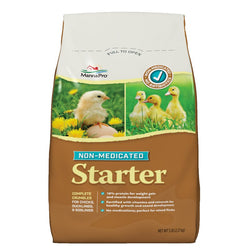How do I introduce my new chicks to other young chicks in the brooder?
Back to blog
Introducing new hens to an established flock can be tricky (see how to do that in the related questions below)---but luckily it's much easier to introduce chicks to chicks than it is adult chickens to adult chickens! This is because the drive to establish a pecking order doesn't start for a few weeks in baby chicks--usually not until they're 6 or more weeks old. Make sure you're getting chicks from an NPIP source like My Pet Chicken.
If you're concerned about communicable illness due to either the source of the chicks or environmental factors (such as exposure en route), consider quarantine. (Read more about biosecurity in the related questions below.)

I'm just like other babies: I just want to eat, drink, sleep--and poop!
Even so, it's not a good idea to just plop your new, days-old chicks into a brooder with your three week olds---whether your new babies have been shipped to you, or you've hatched them yourself. Instead, the new babies will need some time to get oriented to the brooder, figure out what is food and what is not, find the warmth of your brooder heater, learn how to find the waterer and drink, etc. And when it comes to your older chicks, even though they may not be trying to chase down the babies to establish a hard pecking order, they still have no instinct to allow the little ones to eat and drink first. They may not be trying to win influence or drive them away from the flock, but they still won't consider bowling them over or walking on top of them to be uncouth, or some philistine failure of the chicken social contract! So generally, you'll want to give the new babies a few days to acclimate before you mix the different ages of chicks together.
Luckily, it's relatively easy to manage introducing chicks to chicks. There are two main options.
Two methods for introducing chicks to chicks
1. The preferred method is easy: Split your existing brooder into two regions by age group. You can use nearly anything to create your two zones, but it's usually best (not to mention easiest) to use wire mesh like chicken wire or hardware cloth. Cover the edges of your mesh barrier, which could have sharp wire points, with duct tape or something similar so your chicks won't accidentally injure themselves. Once safely in place, the two groups of baby chicks can see each other and even interact through the mesh, without having the youngest, smallest ones overrun by the more active older chicks. Of course, you'll still need to make sure both groups have access to food, water, and heat. After a few days, you can remove your wire barrier and observe how they do together. In most cases, a few days is all they'll need before you can remove the barrier permanently and have one happy, flock.
2. Another way: Set up a second brooder adjacent to your current setup. Depending on what sort of brooder you have, you may find it easier to have two brooders rather than one brooder with dual zones. As with the first method, both broods of chicks will need access to food, water, and heat. After a day or two, you might try introducing them to each other for some "play time," and you can observe how they'll do together. When the little ones seem strong and active enough to deal with the bigger chicks, you can move them all to one brooder. Be sure to do this only when you're comfortable that the space is being shared equally, and everyone can have access to food, water, and heat as they need it. This could be a few days to a week.
About heat for your two broods of chicks
You might be worried about how to provide the correct amount of heat for chicks of two different ages! After all, the new babies need 95 degree heat, while three or four week olds need it to be 10 or 15 degrees cooler! But don't worry; this is easy.
Remember that you want your chicks to have access to those warm temperatures. You don't want your entire brooder to be the same temperature. So, when introducing new baby chicks, make sure one area of the brooder is 95°. Further away from the heater, your brooder might drop to room temperature, and that's okay! Chicks normally warm themselves up underneath mom, and then venture out to forage, explore, and scratch around. When they get cold, they warm up under mom again. All you need to do is make sure they have an area where they can warm up, and areas where they can cool down in they get too hot. If you do that, the chicks will find their own most comfortable area.
So as we've said before, when you look into your brooder, you want to make sure that your chicks are wandering around the whole area and seem content. If you see your youngest babies all hovering, peeping, distressed, directly beneath the heating element, you probably need to check and make sure they are not too cold. If instead you see your oldest chicks staying as far away from the heating element as possible, or panting, then you might need to make sure there is a cooler area of the brooder they can access. It's not a hard process; it just requires attention and judgment. Whenever you make an adjustment, give them a little time and then check to see if their behavior normalizes. Once it does, you'll know you have the heat just right.











